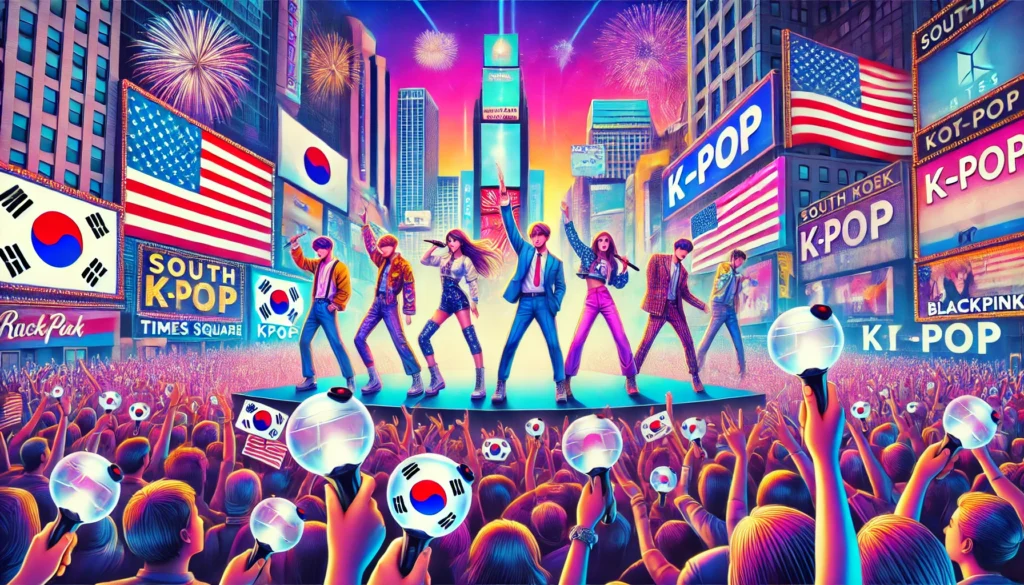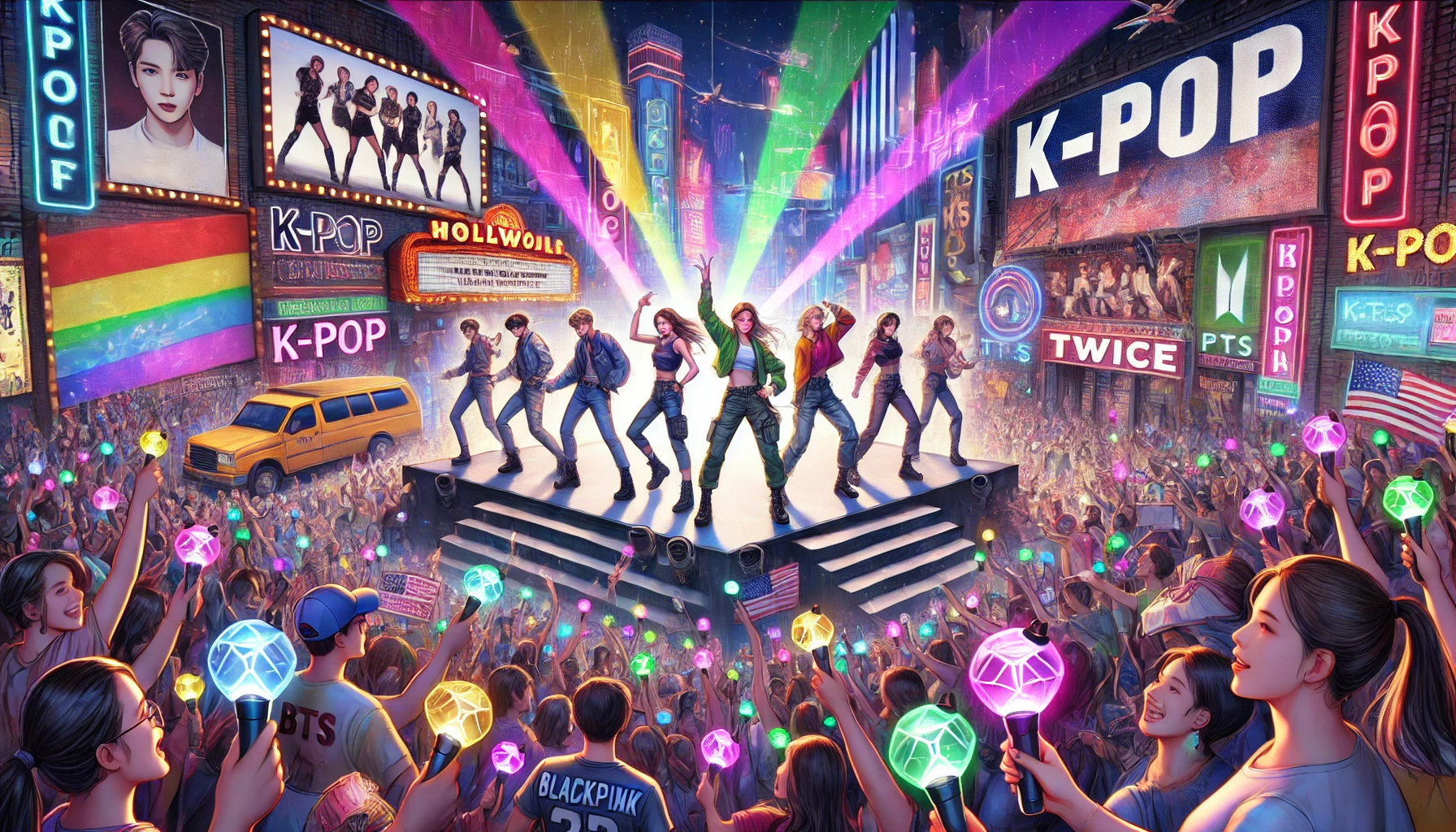Table of Contents
Introduction to K-Pop: A Global Phenomenon
K-Pop, or Korean pop music, has emerged as a significant cultural force that transcends geographical boundaries and resonates with audiences worldwide. Originating in South Korea during the early 1990s, K-Pop has transformed from a localized music genre into a global phenomenon characterized by its catchy melodies, intricate choreography, and visually striking performances. Initially influenced by Western pop music, hip-hop, and R&B, K-Pop has since evolved, incorporating diverse musical styles and richer narratives that appeal to a broader audience.
The rise of K-Pop is often attributed to the development of entertainment companies in South Korea, such as SM Entertainment, YG Entertainment, and JYP Entertainment. These agencies meticulously craft the image of their artists, offering extensive training in singing, dancing, and overall performance. This careful approach not only enhances the production quality of K-Pop but also creates a polished image that captivates listeners. As a result, K-Pop groups like BTS, BLACKPINK, and EXO have gained immense popularity both in South Korea and internationally.
In recent years, the surge of digital media has played a crucial role in K-Pop’s globalization. Platforms such as YouTube, TikTok, and various social media channels have made it easier for fans to discover and share K-Pop music and videos. This accessibility has led to a significant increase in the genre’s fan base in the United States, where K-Pop concerts sell out rapidly, and artists regularly collaborate with American musicians. The vibrant and passionate fandom surrounding K-Pop adds another layer of appeal, as fans engage with one another online and participate in various activities to support their favorite groups.
As K-Pop continues to break through cultural barriers, its influence grows, making it a crucial part of contemporary global music culture. The subsequent sections will delve deeper into the allure of K-Pop, examining its distinct elements and why it has garnered such a dedicated following in America.

The Unique Sound and Style of K-Pop
K-Pop is a vibrant and innovative genre that blends various musical styles to create a unique auditory experience. One of the most astonishing aspects of K-Pop is its ability to seamlessly merge different genres including pop, hip-hop, R&B, and electronic music. This fusion not only attracts diverse listeners but also embodies the versatility that is a hallmark of the K-Pop phenomenon. Artists within this genre often experiment with varied styles in each release, resulting in a refreshing sound that keeps fans eagerly anticipating future projects.
The production quality of K-Pop tracks is another defining characteristic that differentiates it from other music types. High-end studio techniques, well-crafted melodies, and layered vocals contribute to the polished sound that K-Pop is known for. Producers and songwriters dedicate their efforts to ensuring that each track stands out, often incorporating catchy hooks that effortlessly draw listeners in. These hooks are not merely repetitive phrases; they serve to create memorable moments that are essential for audience engagement. This compelling craftsmanship is crucial for making K-Pop songs successful on international charts.
In addition to the auditory elements, K-Pop is equally renowned for its visually striking performances. The fashion worn by K-Pop idols is often at the forefront of cultural trends, allowing them to establish unique identities through their style. From flamboyant costumes to carefully coordinated outfits, the aesthetic appeal is as significant as the music itself. Furthermore, the choreography captivates audiences worldwide, with intricate dance routines that often become viral sensations. The blend of music, style, and performance art in K-Pop not only highlights the dedication of the artists but also underscores why this genre resonates so deeply with fans across the globe.
The Role of Social Media and Streaming Platforms
The rise of K-Pop in the global music scene can be largely attributed to the impact of social media and streaming platforms. These digital channels have created an unprecedented opportunity for fans to discover, engage, and share their favorite K-Pop content. Platforms such as YouTube, TikTok, and Spotify have become instrumental in the dissemination of K-Pop music and culture, allowing artists to connect with a diverse audience beyond South Korea.
YouTube, for instance, serves as a significant launchpad for K-Pop groups. Music videos are often strategically released on this platform, capturing millions of views within hours. The visually captivating choreography and high production quality of K-Pop music videos make them highly shareable, encouraging fans to create their own reaction videos or dance covers. Such user-generated content adds layers to the K-Pop experience, amplifying the song’s reach and further fueling its popularity in regions like the United States.
Similarly, TikTok has emerged as a vital space for K-Pop engagement, where short, catchy clips become viral sensations. The app allows users to participate in dance challenges featuring K-Pop tracks, resulting in a grassroots movement that draws in new fans. The algorithm-driven format helps songs spread rapidly, often leading to chart success as these challenges invite millions to join in on the fun.
Moreover, Spotify and other music streaming services have made K-Pop’s entire discography readily accessible, promoting global playlists that incorporate a variety of artists. This instant access not only elevates the visibility of K-Pop but also fosters community building among fans, as they connect over shared musical interests online. These platforms have undeniably transformed the way K-Pop is consumed and appreciated, making it a staple in the American music landscape.
Fan Culture and Community in K-Pop
The vibrant fan culture surrounding K-Pop is a defining characteristic that distinguishes it from other music genres. Fans, often referred to as “stans,” are deeply engaged in not only the music but also the lives of their favorite idols. This dedication manifests in various ways, such as the formation of organized fan clubs. These clubs serve as a platform for fans to connect, share experiences, and participate in collective activities, fostering a sense of belonging among members. Many K-Pop groups have official fan clubs, which often require membership fees and provide exclusive merchandise, access to special events, and opportunities to communicate with idols.
In addition to the fan clubs, the demand for fan merchandise has soared, reflecting the deep emotional investment fans have in their idols. Items such as light sticks, clothing, and posters are significant not only as collectibles but also as symbols of the connection fans feel with K-Pop culture. This merchandise often becomes a visual representation of loyalty during concerts and events, where fans passionately cheer for their favorite groups, creating an electrifying atmosphere.
Moreover, the relationship between K-Pop idols and their fans is particularly noteworthy. Unlike many western music industries, where the artist-fan dynamic can sometimes seem distant, K-Pop idols often engage with fans through social media and personal appearances, cultivating a closer and more personal connection. Idols routinely express gratitude and recognition for their supporters, which fosters an environment of loyalty and unwavering support. This dynamic not only enhances the experience for fans but also encourages an inclusive global community that transcends cultural boundaries. Fans across the world come together to celebrate their shared passion for K-Pop, creating a strong network of connection that enhances the genre’s appeal.
The Influence of K-Dramas and Variety Shows
The relationship between K-Pop and K-Dramas is a pivotal factor contributing to the genre’s rising popularity in the United States. Korean dramas, known for their engaging narratives and high production quality, often feature K-Pop soundtracks, seamlessly integrating music into the storytelling. This strategic use of K-Pop lends itself to an immersive experience, drawing viewers deeper into the emotional landscape of the drama. As a result, audiences frequently find themselves exposed to new K-Pop songs and artists, sparking interest that transcends the confines of the drama itself.
Moreover, K-Pop idols often make guest appearances in popular variety shows, showcasing not only their musical talents but also their personalities, humor, and charisma. Programs such as “Running Man” and “Knowing Bros” have become platforms where fans can see their favorite idols in a relaxed, informal setting, further endearing them to the audience. This blend of entertainment allows American viewers to connect with K-Pop artists on a more personal level, solidifying their fandom and fueling interest in the artists’ music careers.
Additionally, these shows create a community where fans can come together to discuss their favorite moments and performances, both online and offline. As social media is rife with discussions and fan art inspired by K-Dramas and K-Pop, the interactivity enhances engagement and fosters a thriving culture around these forms of entertainment. Consequently, K-Dramas and variety shows are instrumental in shaping the K-Pop landscape for American audiences. By providing multiple entry points into the K-Pop world, they play a significant role in attracting new fans and expanding the genre’s reach beyond the shores of South Korea.
The Impact of Cultural Exchange and Representation
K-Pop has emerged as a significant force in the realm of cultural exchange, transcending geographical boundaries and establishing a deep connection with audiences around the world, particularly in the United States. This genre of music not only entertains but also serves as a medium for promoting Asian culture and aesthetics within mainstream media. As K-Pop continues to rise in popularity, it effectively introduces a diverse array of cultural nuances, fashion, and artistic expression that resonates with an increasingly diverse American audience.
One of the most notable impacts of K-Pop is its powerful role in reshaping perceptions of Asian culture. Historically, representation of Asian artists in the global music industry has been limited and often stereotypical. However, the influx of K-Pop acts—characterized by their dynamic performances, high production values, and a unique blend of musical influences—has started to challenge these stereotypes. Groups like BTS, BLACKPINK, and EXO have not only showcased their talents but have also become symbols of a shifting paradigm in the representation of Asian artists in entertainment.
Furthermore, K-Pop promotes the principles of inclusivity and diversity. By acknowledging and celebrating various cultures and identities, it helps to create a more comprehensive understanding of the global music scene. This genre encourages collaboration among artists from different backgrounds, breaking down barriers and fostering a sense of community among fans. Such cross-cultural interactions not only enrich the musical landscape but also empower individuals to embrace differences, cultivating a climate of acceptance and understanding. Through these initiatives, K-Pop has successfully appealed to a broader audience in the U.S., making it a vital component of the evolving narrative surrounding cultural representation in music.
K-Pop Tours and Live Performances: A Different Experience
K-Pop concerts have emerged as a unique phenomenon on the global stage, attracting millions of fans, particularly in the United States. These live performances are characterized by their high-energy atmosphere, elaborate staging, and a level of production that often exceeds expectations. For many Americans, attending a K-Pop concert is not merely a show, but an immersive experience that creates lasting memories and emotional connections.
The scale and precision of K-Pop tours contribute significantly to their appeal. These events often feature intricate choreography, stunning visuals, and cutting-edge technology, creating an environment that captivates the audience. For instance, state-of-the-art lighting, pyrotechnics, and set designs work together to enhance the performance, turning each concert into a multi-sensory experience. This meticulous attention to detail not only showcases the artists’ dedication but also emphasizes the importance of fan engagement.
American audiences have shown an immense enthusiasm for these performances, often traveling long distances to attend. The opportunity to witness their favorite stars live fosters a deep emotional connection, as fans actively participate through cheering, singing along, and even completing choreography in sync with their idols. This collective energy forms a strong bond among audience members, uniting fans from diverse backgrounds who share a common passion for K-Pop.
Moreover, K-Pop artists often take the time to interact with fans during concerts, whether through fan meetings or social media engagement. This direct communication allows for a personable touch that enhances the overall concert experience, making attendees feel valued and connected to the artists. Such dynamics are not as prevalent in other music genres, setting K-Pop apart from the broader concert landscape.
In sum, K-Pop tours and live performances offer a distinctive experience for American fans, blending visual spectacle with emotional engagement. The appeal of K-Pop is largely attributed to this unique combination, solidifying its presence in the American entertainment scene.
Future Trends: K-Pop’s Growing Influence in America
The K-Pop phenomenon has not only captivated audiences across Asia but has also carved a significant niche within the American music landscape. As we look towards the future, it is clear that the influence of K-Pop in the United States is poised to expand even further. With the current trajectory indicating a steady rise in popularity, the potential for K-Pop to evolve and reshape cultural norms is immense.
One of the most promising trends is the likelihood of increased collaboration between K-Pop artists and Western musicians. Several high-profile combinations have already set a precedent, from BTS’s partnerships with artists like Halsey to BLACKPINK’s collaborations with Dua Lipa. Such alliances not only enhance the global reach of these artists but also foster a cross-cultural exchange that can introduce American fans to diverse musical styles and innovative performance concepts. As these collaborations become more commonplace, they will likely bolster K-Pop’s presence on charts and playlists across the U.S.
Moreover, as more American artists and producers seek out the kinetic energy and diverse aesthetics characteristic of K-Pop, the genre itself may start to influence the style and production choices within Western pop music. This reciprocal relationship presents countless opportunities for both markets, allowing K-Pop to continuously innovate while simultaneously enriching the American music scene.
In conjunction with this evolution, social media and streaming platforms will play pivotal roles in facilitating the entry of K-Pop into mainstream consciousness. As platforms like TikTok become crucial for music discovery, K-Pop artists can harness these tools to engage with wider audiences, generate fan-generated content, and establish a more personal connection with listeners. Thus, the K-Pop wave shows no signs of receding; instead, it is set to grow, marking its indelible mark on the American cultural landscape.
Conclusion: Embracing the K-Pop Wave
As we have explored throughout this blog post, K-Pop has emerged as a significant cultural phenomenon that resonates deeply with American audiences. The genre’s vibrant blend of diverse musical styles, captivating visuals, and meticulously crafted performances appeals to a wide range of listeners, contributing to its widespread popularity. The dedicated fanbase, often referred to as “ARMYs,” exemplifies the passionate commitment many Americans have towards their favorite K-Pop idols and groups.
The influence of K-Pop extends beyond just music; it acts as a bridge facilitating cultural exchange between Korea and the United States. Fans have embraced Korean language and culture, showcased through fan events, social media, and even dance challenges. This cross-cultural engagement not only enriches the experience for fans but also fosters a broader understanding and appreciation of Korean traditions and societal values. Moreover, the rise of K-Pop has sparked interest in South Korea’s fashion, beauty standards, and entertainment history, marking a significant convergence of global cultures.
We encourage readers to delve into the world of K-Pop for themselves. Exploring the extensive discography of various groups, watching performances, and participating in fandom activities can deepen your understanding of this dynamic genre. With an increasing number of collaborations between K-Pop artists and mainstream American musicians, the boundaries that once separated different music cultures continue to blur. The ongoing evolution of K-Pop reflects not only a musical trend but also the shared love for music across the globe. Engage with K-Pop, and discover the excitement that so many have already embraced. A vibrant community awaits, where the love for engaging music unites fans from diverse backgrounds.






